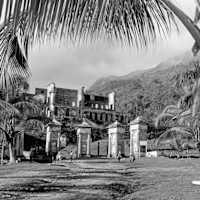The artist Firelei Báez created an immersive installation of the lost Haitian palace Sans Souci. Haitian historian Marlene Daut ruminates on what the castle's ghost means during a turbulent year in Haitian history.
BY
MARLENE DAUT
PUBLISHED: OCT 8, 2021
I visited Dominican artist Firelei Báez’s large-scale installation of King Henry Christophe of Haiti’s famous 19th-century palace during the final weekend of its exhibition at Boston’s ICA Watershed. Báez’s re-creation of the breathtaking castle called Sans-Souci (meaning “without worry”), which was partially destroyed by an earthquake in 1842, reflects as much the deep history of the Caribbean island Haiti shares with the Dominican Republic as it does contemporary political problems and environmental concerns in the region.
This year, Haiti experienced all the phenomena called forth by the installation: anti-government demonstrations, the death of their head of state, a massive earthquake in the southern city of Les Cayes, followed by a tropical storm that brought devastating floods. This was all compounded when in September, border agents in Del Rio, Texas, began expelling Haitian migrants seeking U.S. asylum. They had been sheltering under a bridge near the Rio Grande River between Mexico and the United States.
As a Haitian American, I couldn’t help but to feel all too acutely the painful relevance of Báez’s artwork as it intersects with the ongoing crises facing Haitians in Haiti and Haitian migrants across the Americas. But as a historian of the Caribbean, who is currently writing a book about the Kingdom of Haiti, I couldn’t help but feel a sense of gratitude that this enormously important but relatively unknown history appeared in a city like Boston, which after Miami and New York, contains the third-largest Haitian-American community in the United States.
